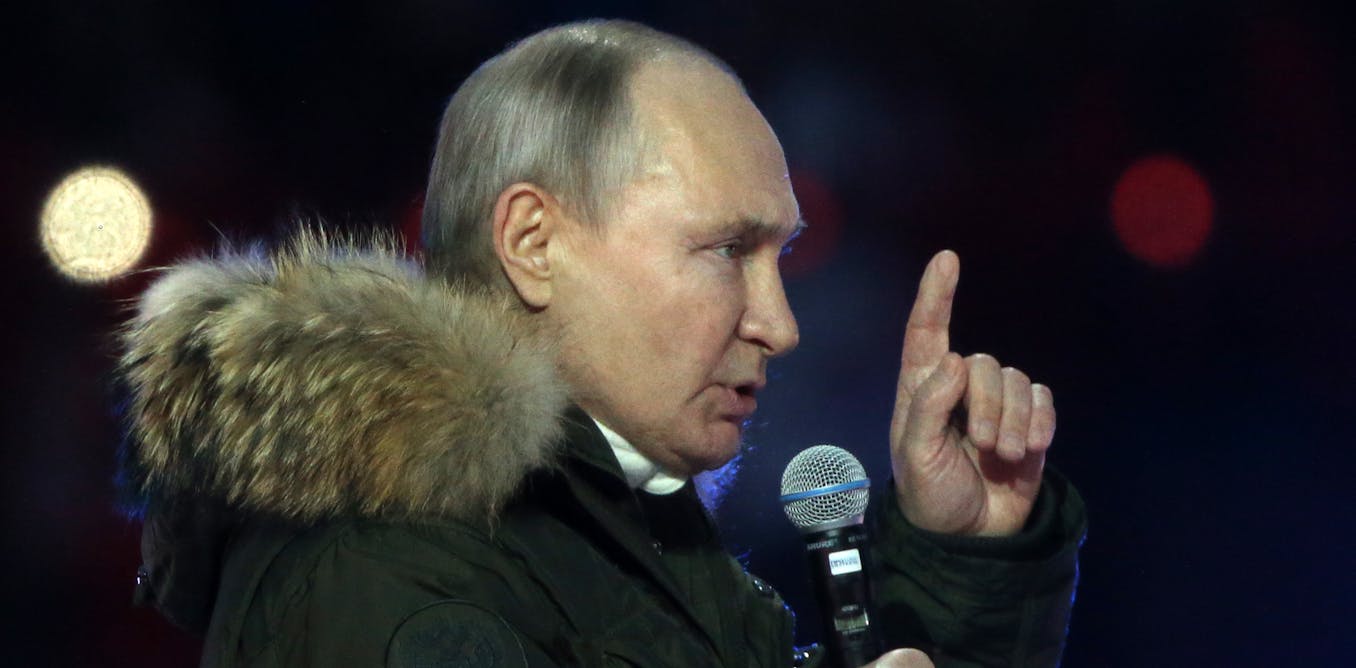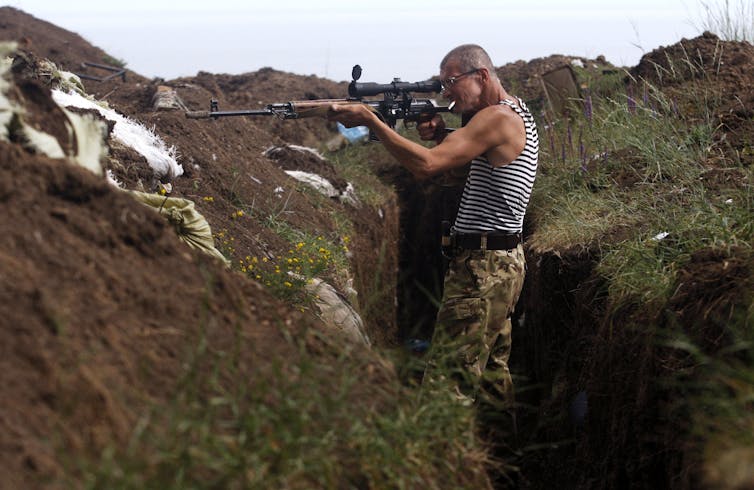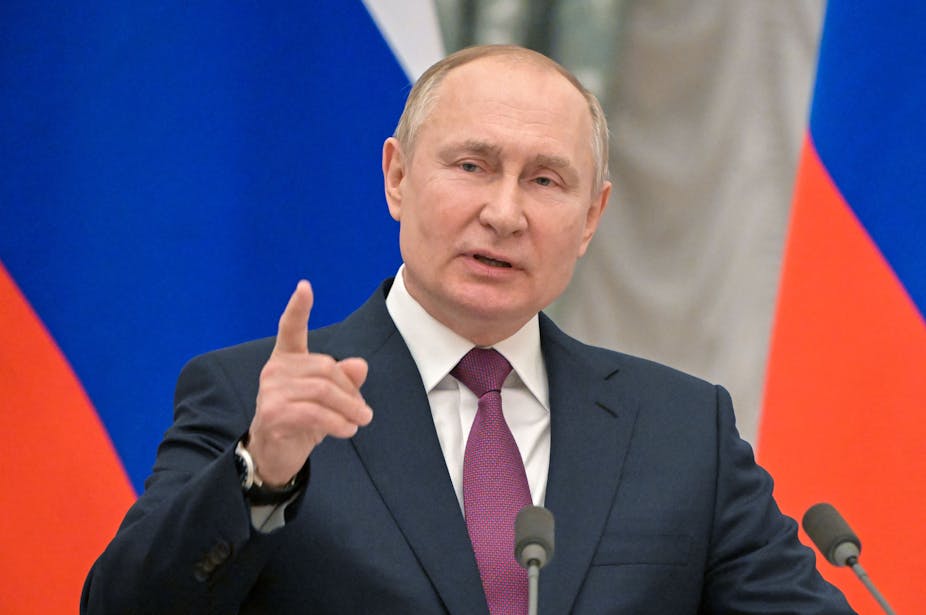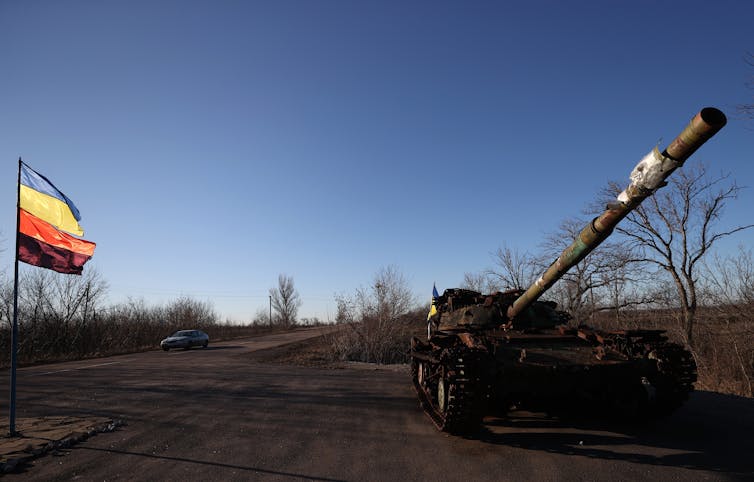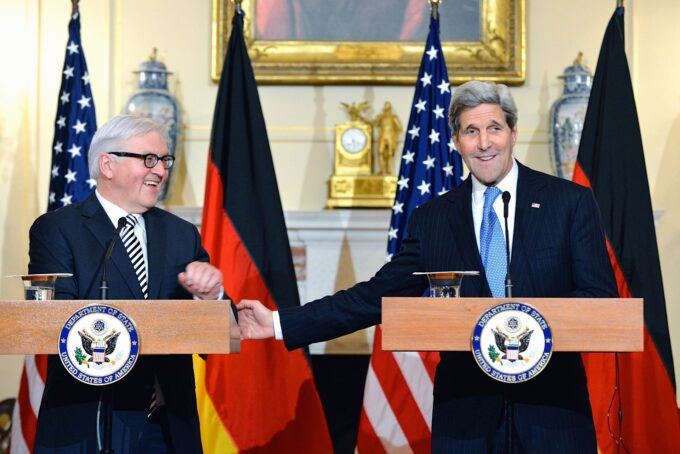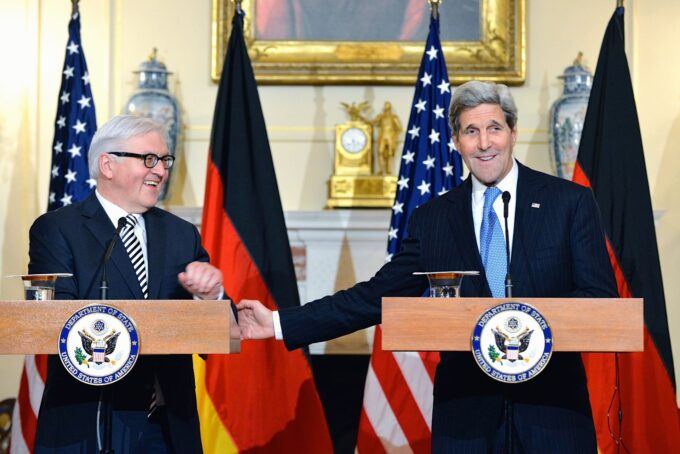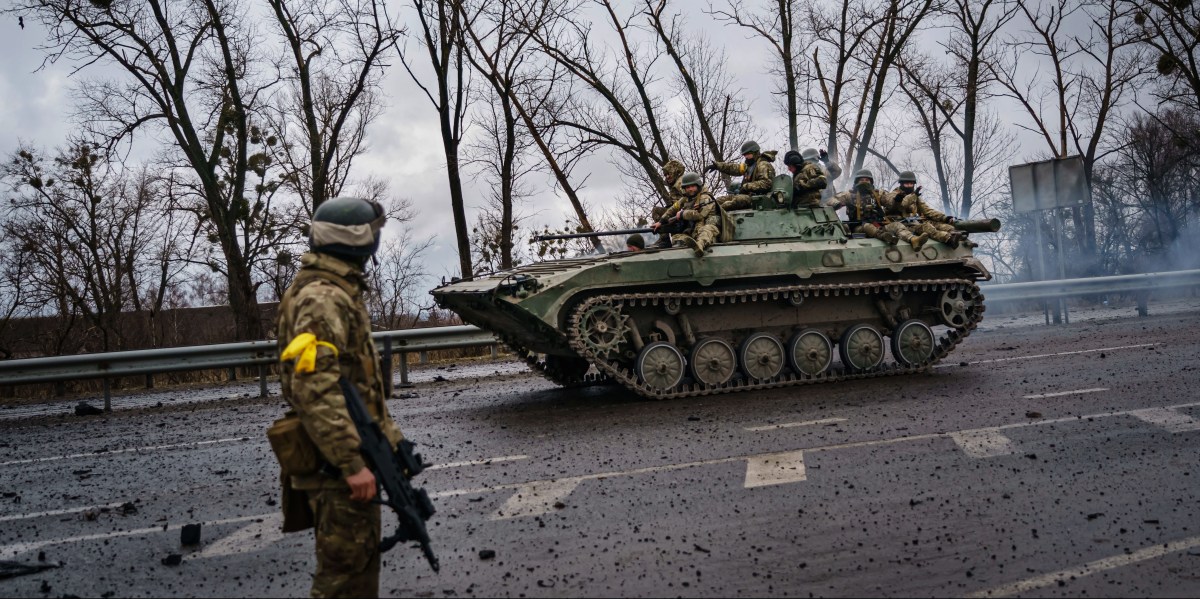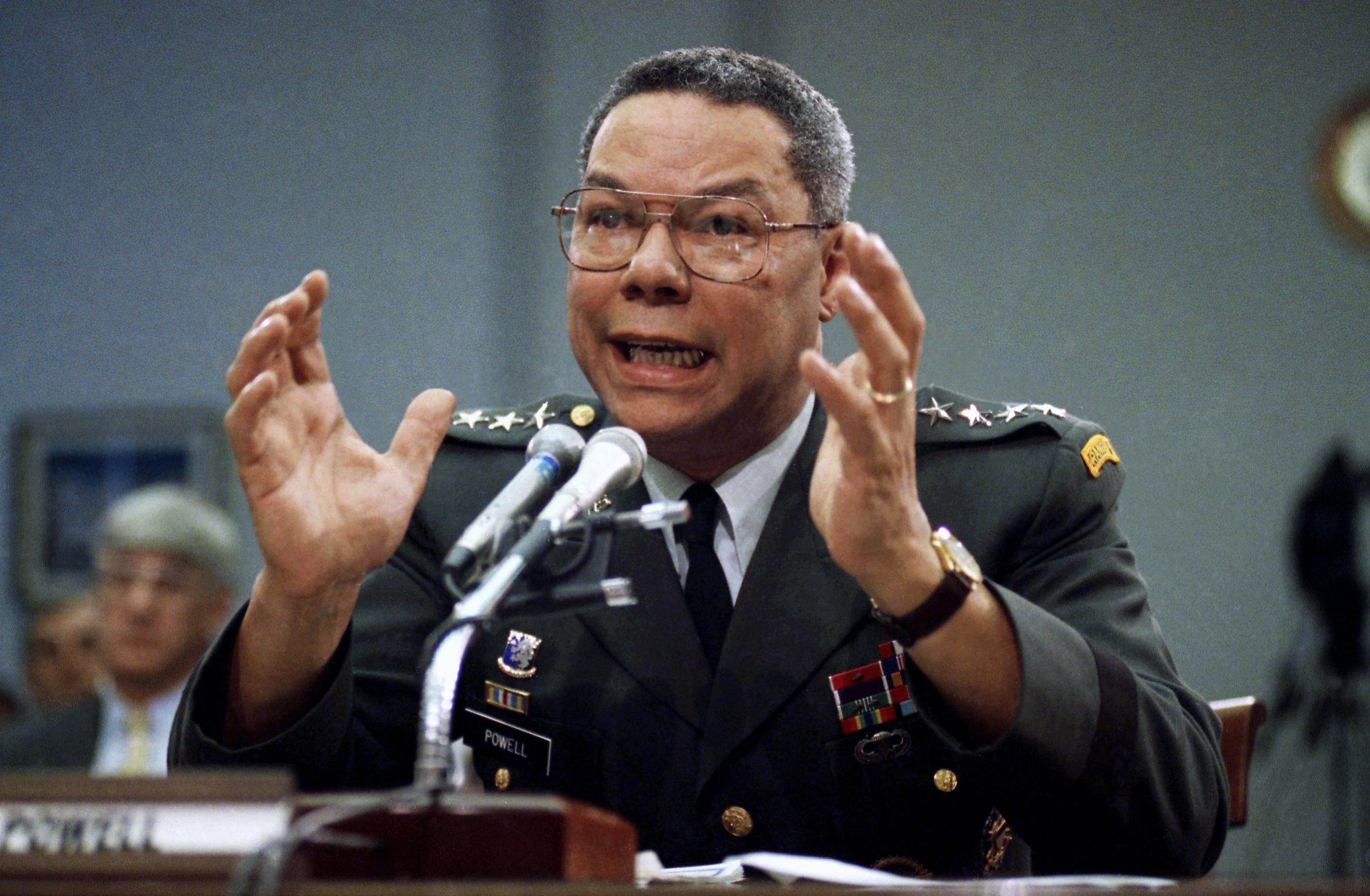The fact that Putin is trying to justify the unjustifiable in Ukraine does not mean we should ignore the U.S. actions that fuel his narrative.

theintercept.com
Putin’s Criminal Invasion of Ukraine Highlights Some Ugly Truths About U.S. and NATO
The fact that Putin is trying to justify the unjustifiable in Ukraine does not mean we must ignore the U.S. actions that fuel his narrative.
A Ukrainian military vehicle speeds by on a main road near Sytnyaky, Ukraine, on March 3, 2022
There are no excuses or justifications for what Vladimir Putin is doing in Ukraine. His brutal invasion is a bald-faced act of aggression, replete with war crimes, and is rightly being condemned as such by large numbers of people and nations across the globe. The targeting of civilian populations and infrastructure is a heinous act that belongs in the annals of major nation state crimes alongside the U.S. invasion of Iraq in 2003.
Many governments of the world have denounced Putin’s actions. But when it comes to the U.S. and its NATO allies, these condemnations demand greater scrutiny. While many statements from Western leaders may be accurate regarding the nature of Russia’s actions, the U.S. and other NATO nations are in a dubious position to take a moralistic stance in condemning Russia. That they do so with zero recognition of their own hypocrisy, provocative actions, and history of unbridled militarism — particularly in the case of the U.S. — is deeply problematic. From the beginning of this crisis, Putin has exploited the militarism and past bombing campaigns of the U.S. and NATO to frame his own warped justification for his murderous campaign in Ukraine. But the fact that Putin is trying to justify the unjustifiable does not mean that we must ignore the U.S. actions that fuel his narrative.
In recent days, U.S. and NATO officials have highlighted Russia’s use of banned weapons, including cluster munitions, and have said their use constitutes violations of international law. This is indisputably true. What goes virtually unmentioned in much of the reporting on this topic is that the U.S., like both Russia and Ukraine,
refuses to sign the Convention on Cluster Munitions.
The U.S. has repeatedly used cluster bombs, going back to the war in Vietnam and the “
secret” bombings of Cambodia. In the modern era, both Presidents Bill Clinton and George W. Bush used them. President Barack Obama
used cluster bombs in a
2009 attack in Yemen that killed some 55 people, the majority of them women and children. Despite the
ban, which was finalized in 2008 and went into effect in 2010, the U.S.
continued to sell cluster bombs to nations like Saudi Arabia, which regularly used them in its attacks in Yemen. In 2017, President Donald Trump reversed an internal U.S.
policy aimed at limiting the use of certain types of cluster munitions, a move which a Human Rights Watch expert
warned “could embolden others to use cluster munitions that have caused so much human suffering.” None of this exonerates Russia for its unconscionable use of cluster bombs against civilians, but these facts are clearly relevant when assessing the credibility of the U.S.
It is much easier to express outrage at the actions and crimes of a foreign autocrat than it is to come to terms with the conduct of your own government. This is why the images of masses of Russians protesting in the streets is a more powerful repudiation of Putin’s war than the rhetoric from U.S. politicians on cable news or the statements from NATO officials.
It is also true that the laws of war and international law should apply not only to the declared bad guys of the moment or to parties that unilaterally attack other nations, but also to every nation — including our own. Putin has framed his aggression against Ukraine in part as a response to NATO expansion, and he and other Russian officials have in recent weeks invoked the 1999 Kosovo war as precedent for Russia’s current actions in Ukraine.
Moscow’s argument is that the U.S. and NATO, under the “pretext” of “humanitarian intervention,” and with no United Nations authorization, unilaterally bombed Serbia for more than two months in 1999 followed by a ground incursion into Kosovo. In February, Russian Foreign Minister Sergey Lavrov suggested, in remarks at the U.N., that the U.S. had set a precedent with the Kosovo war and that this negated the value of Western critiques of Russia’s plans to attack Ukraine. “I have to recall these facts, because some Western colleagues prefer to forget them,” Putin
said in his February 24 speech. “When we mentioned the [Kosovo war], they prefer to avoid speaking about international law.”
Although many of Putin’s comparisons are nonsense and — even when they are cogent — do nothing to justify his own current murderous campaign, there are relevant insights we can extract from reviewing some of
NATO’s actions in Kosovo. The most direct analogy in recent U.S. military history to Putin’s large-scale ground invasion of Ukraine is obviously the Iraq War. Yet it’s important to examine the Kosovo air war because it highlights military tactics that the U.S. and NATO now rightly condemn Russia for using. Like Iraq, it also illustrates the entrenched double standard that permeates the consistently hypocritical U.S. response to the actions of its enemies.
Slobodan Milošević had for many years imposed a system of minority rule, repression, and terror against Kosovo Albanians, which constituted 90 percent of the southern province’s population. Beginning in 1989, he began to hack away at Kosovo’s long-held autonomous status within the Yugoslav federation. The situation steadily deteriorated over the next decade as Yugoslavia disintegrated, and by 1998 the U.S. was threatening to intervene militarily to confront Milošević, accusing his forces of massacring and terrorizing Albanian civilians and plotting a wider campaign of ethnic cleansing.
Throughout the year leading up to the NATO bombing, Milošević’s forces regularly clashed with armed insurgents from the separatist Kosovo Liberation Army. After the killing of several police officers in early 1998, Milošević’s forces
launched a murderous retaliatory
campaign in which they repeatedly killed civilians, including the family members of KLA guerrillas. Human rights groups also documented abuses by the KLA, including killings and kidnappings of civilians, though on a far smaller scale than those carried out by Serbian forces. This situation, combined with the general state of repression of ethnic Albanians, brought Kosovo to wider public attention and drew sharper focus from the U.S. and NATO, which stood accused, earlier in the decade, of failing to respond earlier to the
mass slaughter of Bosnian Muslims.
There were also influential voices in the U.S. — including then-Sen. Joe Biden, who advocated
directly targeting Serbia and Milošević since the Bosnia war — and the worsening situation in Kosovo helped them make their case. “We talk about humanitarian interests — it far exceeds the humanitarian interest,” Biden said in October 1998. “If I were president, I would just bomb him, and I mean that sincerely, and I would have the NATO allies come along.” Belgrade’s position was that it was engaged in a fight against “terrorist” KLA militants and that the U.S. and NATO were attempting to undermine the country’s sovereignty, a position supported by both Russia and China.
As the violence
intensified in early 1999, and reports of Serbian police and special forces killing civilians garnered more public attention, the prospect of a U.S.-NATO war became real.
By March 1999, an
estimated 460,000 residents of Kosovo had been internally displaced, forced from their homes, or fled to neighboring countries. The U.S.-NATO position was that given the mass atrocities committed by Bosnian Serb forces throughout the early 1990s in Bosnia, particularly the massacre of 8,000 Bosnian Muslim men and boys at Srebrenica in July 1995, it was necessary to stop Milošević from accelerating a campaign of ethnic cleansing against the majority ethnic Albanian population of Kosovo. Multiple subsequent war crimes trials at the International Criminal Tribunal for the former Yugoslavia determined the Srebrenica massacre to be an act of genocide.
NATO asserted that in order to avert a bombing campaign, Milošević would have to sign the
Rambouillet Accord and agree to the deployment of as many as 30,000 NATO-led troops in Kosovo. The document, drafted by NATO and signed by representatives of the Kosovo Albanians, contained a
provision that stated “NATO personnel shall enjoy, together with their vehicles, vessels, aircraft, and equipment, free and unrestricted passage and unimpeded access” not just in Kosovo but also throughout the entire Federal Republic of Yugoslavia. In mid-March, international monitors
pulled out of Kosovo as NATO military action grew imminent. Milošević’s forces used the opportunity to intensify their
rampages through KLA strongholds, burning Albanian homes and shops. Clinton
dispatched his envoy Richard Holbrooke to Belgrade to personally meet with Milošević on March 23. “We presented the ultimatum to Milosevic that if he didn’t sign the agreement, the bombing would start,” Holbrooke
recalled. “And he said, ‘No.’”
Russia was the most powerful ally of Milošević and was dead set against the U.S. and NATO bombing Serbia. Clinton failed to get U.N. approval for a military operation, in part because of Russia’s repeated threats of a veto, so he sidestepped the fierce debates in both Congress and the U.N. and, on March 24, proceeded with a NATO military operation. Congress never authorized the war despite the
efforts of Biden, one of the most passionate proponents of bombing Serbia. Russia, for its part, denounced the bombing as prematurely abandoning diplomacy and characterized it as a violation of the U.N. charter. From Moscow’s perspective, NATO was steadily asserting its dominance over the republics of the former Yugoslavia, which had been a socialist, nonaligned state since the end of World War II.
At the end of the bombing, Russian forces entered Kosovo ahead of NATO and briefly took control of a key airport resulting in a showdown between NATO and Russia, which some analysts feared could have severe consequences. Putin, who at the time was head of Russia’s national security council, has actually
claimed he had a role in the incident. While it was ultimately resolved peacefully, at one point during the standoff a British general refused to implement the orders of U.S. Gen. Wesley Clark, the NATO supreme allied commander, to block the runway. Lt. Gen. Michael Jackson reportedly
told Clark, “I am not going to start Third World War for you.” The U.S. ultimately established a large military base in the Balkans, Camp Bondsteel, and led the effort to make Kosovo, at the time a Serbian province, an independent state. To Russia, this campaign constituted an act of aggression by NATO, in circumvention of the U.N., that carved up the territory of a Russian ally in Europe and resulted in a new U.S.-NATO military base in Europe.
“High U.S. officials confirm that it was primarily the bombing of Russian ally Serbia — without even informing them in advance — that reversed Russian efforts to work together with the U.S. somehow to construct a post-Cold War European security order,” said Noam Chomsky in a recent
interview. This “reversal accelerated with the invasion of Iraq and the bombing of Libya after Russia agreed not to veto a UN Security Council Resolution that NATO at once violated.”
None of this history lends an iota of legitimacy to Putin’s invasion of Ukraine. What it does offer, however, is an opportunity for the citizens of the U.S. and NATO countries to review the history of their own forces and to examine the ways in which our conduct damages our moral standing and ultimately gives propagandistic fodder to leaders like Putin.
The fact that Milošević was a murderous gangster who orchestrated mass deportations, atrocities, and widespread killings of ethnic Albanians in Kosovo does not justify NATO’s
repeated use of
cluster bombs, including on a crowded marketplace and hospital in the city of Niš, killing more than a dozen people. Human Rights Watch
determined NATO killed between 90 to 150 civilians in cluster bomb attacks. Nor does it exonerate Clark, the NATO supreme allied commander, for ordering the deliberate missile attack on Radio Television Serbia that killed 16 media workers in April 1999, an act which Amnesty International
labeled a war crime. It does not excuse the U.S.
bombing of the Chinese Embassy (which killed three journalists), or any of the
other U.S.-NATO
attacks that killed civilians.
The U.S. and its allies also sought, at times, to cover up or justify incidents in which they killed civilians. In one attack, NATO struck a civilian passenger train on a bridge, killing 10 people. It
later released a videotape that was played at three times the speed, making it appear as though the strike was a split-second decision and a tragic mistake. But moments after the strike, NATO fired another missile at the train. In another incident, NATO
bombed a convoy of Albanian refugees fleeing Serb forces on April 14, 1999. Some 73
civilians, including 16 children, were killed in the attack, which was carried out by an American F-16. After initially suggesting that Serbian forces had killed the refugees, NATO was forced — when international journalists traveled to the scene — to
admit responsibility for the strike. NATO then expressed “deep regret” for what it labeled a mistake, though NATO spokesperson Jamie Shea also
asserted that “sometimes one has to risk the lives of the few to save the lives of the many.” A month later, NATO
bombed another convoy of Kosovo Albanian refugees in a
similar strike.
The
overwhelming majority of Kosovo Albanians who were killed by Serbian forces perished after the NATO bombing began. Milošević unleashed both conventional and special units as well as vicious paramilitaries in a “systematic and deliberately organized” mass killing and forced displacement operation. The Independent International Commission on Kosovo
concluded, “The NATO air campaign did not provoke the attacks on the civilian Kosovar population but the bombing created an environment that made such an operation feasible.” More than 8,600 Albanian civilians were killed or disappeared between 1998-2000,
according to human rights groups; more than 2,000 Serb, Roma, and other non-Albanian civilians died or went missing during the same period.
“Within nine weeks of the beginning of the air strikes, nearly 860,000 Kosovo Albanians fled or were expelled,” according to a
report from the U.N. High Commissioner for Refugees. They did so amid a campaign of terror, rape, and pillaging by both official and paramilitary forces. “The NATO strikes were accompanied by escalating violence on the ground and a large refugee outflow that included organized expulsions,” according to the UNHCR. “The sequence of violence and displacement underlined the importance of the Western powers in the events that produced the refugee emergency.” After the war, when NATO occupied Kosovo, some 200,000 Serbs, Roma, and other minorities fled their homes, the UNHCR found.
These facts do not justify a single thing Milošević and his forces did, and Milošević deserved his
indictment for war crimes. International prosecutors
charged that Milošević “planned, instigated, ordered, committed or otherwise aided and abetted in a deliberate and widespread or systematic campaign of terror and violence directed at Kosovo Albanian civilians.” The vast majority of the charges against Milošević were for killings and other crimes against Albanians that occurred after the start of the NATO bombing. In 2001, after being ousted from power amid his attempts to overturn an election he lost, Milošević was arrested by Serbian special forces in the middle of the night and extradited to The Hague to face trial for his role in mass killings and other atrocities in Bosnia, Croatia, and Kosovo. He died in jail before his trial ended. The crimes of despots, dictators, and thugs — including vile criminals like Milošević — do not give the U.S. and NATO permission to kill civilians. Nor do they grant authority to the U.S. to bomb other nations for 78 days, particularly when Congress has explicitly declined to authorize the action. The crimes of declared enemies also do not erase the culpability of the U.S. and its personnel for war crimes.
It is precisely the history of these actions by the U.S. and NATO that Putin has sought to weaponize in his insane attempts to justify his invasion of Ukraine. That some of these claims are rooted in fact does not absolve Putin of a single Russian atrocity. But citizens of the U.S. and other NATO nations should deeply examine whether they support the use by their own governments of some of the very tactics and weapons favored by Putin. It is also relevant that to this day there has been no accountability for the crimes committed by the U.S. in its invasion and occupation of Iraq, its 20-year
war in Afghanistan, the post-9/11 CIA
torture and kidnapping program, or the killing of civilians in drone and other airstrikes in numerous countries. The U.S. has
systematized a self-exoneration
machine. And Russia and every nation on Earth knows it.
Since the invasion of Ukraine began, people expressing horror and outrage at Putin’s actions in Ukraine while also referencing the history of the U.S. and NATO governments have been portrayed as traitors or apologists for Russia. This is a classic tactic in the history of pro-war discourse; it has been used throughout U.S. history and was a common cudgel used to attack anti-war views in the aftermath of 9/11.
There is no contradiction between standing with the people of Ukraine and against Russia’s heinous invasion and being honest about the hypocrisy, war crimes, and militarism of the U.S. and NATO. We have an undeniable moral responsibility to prioritize holding our own government accountable for its crimes because they are being done in our names and with our tax dollars. That does not mean we should be silent in the face of the crimes of Russia or other nations, but we do bear a specific responsibility for the acts of war committed by our own nations.
Some prominent U.S. politicians and diplomats have also called for collective punishment against ordinary Russian people in order to pressure them into toppling Putin’s government, and Sen. Lindsey Graham went so far as to openly
encourage Russians to assassinate Putin. While many opponents of Russia’s invasion and Putin have been clear that they do not hold Russian people responsible for the crimes of their leaders, some high-profile U.S. political figures have taken a different stance. “There are no more ‘innocent’ ‘neutral’ Russians anymore,”
tweeted Michael McFaul, the former U.S. ambassador to Russia under Obama. “Everyone has to make a choice — support or oppose this war. The only way to end this war is if 100,000s, not thousands, protest against this senseless war. Putin can’t arrest you all!” McFaul later deleted the tweet. Ordinary Russians will be key to any meaningful hope of ending this war and Putin’s insanity, but we can’t overlook the brutality they face from their own government. Those who are protesting inside of Russia deserve immense credit for their bravery. Sanctions aimed at billionaire Putin cronies and government officials responsible for this invasion are fundamentally different from sanctions that directly impact civilians in an effort to blackmail them into an uprising against a regime that has shown no compunction about violently repressing and at times murdering dissidents.
The global response to Putin’s war has already exposed the tragic double standard when it comes to war victims. The people of Yemen have been
suffering for more than a decade under a merciless campaign of bombing initiated by Obama in 2009 that morphed into a scorched-earth campaign by U.S.-armed-and-supported Saudi Arabia, which continues to this moment. How many of the people with Ukrainian flag avatars on their Twitter profiles have spent days or weeks pleading for the world to stand up for ordinary Yemenis living under the hell of American bombs and Saudi warplanes? The same question applies in the case of the Palestinians who live under an
apartheid state imposed by Israel and backed up by a sustained campaign of annihilation
supported and
encouraged by the U.S. How can people argue in favor of Ukrainian rights to self-defense while simultaneously stripping Palestinians of that same right?
Vladimir Putin and the Russian officials responsible for this invasion of Ukraine should face justice. Once the evidence has been gathered, every war crime should be investigated, indictments issued, and prosecutions undertaken. The obvious venue for this would be before the International Criminal Court. Yet here is an inconvenient fact: The U.S. has
refused to ratify the Rome Statute, which established the ICC. In 2002, Bush signed legislation that
authorizes the U.S. to literally conduct military operations in The Hague to liberate any American personnel brought to trial for war crimes. It is indefensible that the U.S. has established a precedent that powerful nations need not be held accountable for their crimes. It is a precedent that Russia knows well, exploits regularly, and will certainly use again and again.

 theconversation.com
theconversation.com
